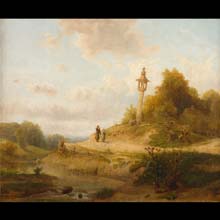
material: oil on canvas
dimensions: 53 × 64 cm
description: Path by a Stream painted during Wojciech Gerson’s studies in Saint Petersburg, is an example of his early landscapes. It reveals not only the artist’s inspiration by the works of 17th-century Dutch masters, but also his willingness to break with the existing landscape patterns. The hilly landscape includes several motifs which are supposed to signify its native character: a stream, a sandy path, a wattle fence, a roadside shrine and a thatched cottage. The figures of an old man and a girl dressed in regional costumes, used as staffage in this work, do not dominate the view, but are an integral part of nature. Despite an inclination to idealize, the picture shows realist tendencies found an attempt to convey the time of the year and day as well as atmospheric phenomena. Gerson gave up landscape painting in the 1860s. Although his talent manifested itself most fully in this genre, a sense of duty towards his country made the artist devote himself to history painting. Aleksandra Krypczyk
exposition: The Gallery of 19th Century Polish Art in Sukiennice,
The Cloth Hall, 1, Main Market Square
key: Realism, polish impressionism, beginnings of symbolism >>>
dimensions: 53 × 64 cm
description: Path by a Stream painted during Wojciech Gerson’s studies in Saint Petersburg, is an example of his early landscapes. It reveals not only the artist’s inspiration by the works of 17th-century Dutch masters, but also his willingness to break with the existing landscape patterns. The hilly landscape includes several motifs which are supposed to signify its native character: a stream, a sandy path, a wattle fence, a roadside shrine and a thatched cottage. The figures of an old man and a girl dressed in regional costumes, used as staffage in this work, do not dominate the view, but are an integral part of nature. Despite an inclination to idealize, the picture shows realist tendencies found an attempt to convey the time of the year and day as well as atmospheric phenomena. Gerson gave up landscape painting in the 1860s. Although his talent manifested itself most fully in this genre, a sense of duty towards his country made the artist devote himself to history painting. Aleksandra Krypczyk
exposition: The Gallery of 19th Century Polish Art in Sukiennice,
The Cloth Hall, 1, Main Market Square
key: Realism, polish impressionism, beginnings of symbolism >>>












